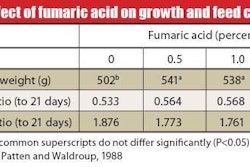Improving growth rate in the finishing herd by just 70g per day could help hard-pressed pig farmers increase returns by £2.86 per pig, amounting to over £30,000 for the annual output from a 500-sow herd, according to Ed Sutcliffe, technical director of pig-breeding company ACMC.
Britain still lags behind most of the continental industries in this area and therefore has plenty of scope to improve, he points out. "According to a BPEX survey, only one other country, Italy, reports its pigs as growing slower and this is largely influenced by production for the specialist Parma ham trade."
Increased margins
Increasing the average daily live weight gain of British pigs from 655 g to 727 gthe difference between the average' and top 10 percent' of herds quoted in the BPEX Pig Yearbook 2007over the 30 kg-to-slaughter period could increase finishing weight by 7.7 kg per pig. This extra saleable meat would improve returns by £6.55 per pig, increasing the margin by £2.86 after allowing for the cost of additional feed.
For farmers already taking pigs near to the limit of their contract weight, growing pigs faster would mean that they would reach their finishing weight 10 days earlier, reducing the cost of feed for maintenance. This would also have the advantage of increasing throughput, taking the pressure off housing space and allowing more time for cleaning and disinfection routines which are known to improve health and performance.
Other countries come to the UK for breeding stock because it has some of the most advanced genetics in the world, which includes traits for feed conversion and growth rates, so why do British pigs grow slower?
"It's partly down to our more extensive systems and also due to the ageing housing and lighter UK slaughter weights," says Mr Sutcliffe. But he also believes many producers could improve growth rates simply by carefully monitoring throughput of pigs at each stage of the finishing system.
"Bottlenecks can easily occur at different production stages, when pigs get held up and are not moved on to the next housing phase at the right time. Ironing these out, by focused management, can go a long way to improving growth right through the system," he said.

















